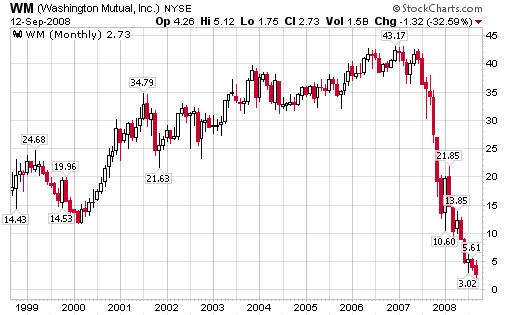The failure of Washington Mutual Bank on September 28, 2008 was the largest banking failure in U.S. history.
After nervous depositors starting withdrawing billions of dollars, regulators feared that a run on the Bank would cause a nationwide panic and decided to close the bank. The FDIC, acting as receiver, sold Washington Mutual to JP Morgan.
Washington Mutual, Inc., the holding company for Washington Mutual Bank, filed for bankruptcy the day after the FDIC seized Washington Mutual Bank. Since the purchase agreement for Washington Mutual Bank between the FDIC and JP Morgan excluded all claims by equity holders and unsecured creditors, these parties were forced to pursue all claims against bankrupt Washington Mutual, Inc.
Shareholders, in accordance with Federal law, have the lowest claims priority in a bankruptcy and usually get wiped out. In late 2010, a bankruptcy court appointed examiner told shareholders that there was little hope of any recovery. The stock of Washington Mutual, Inc., which traded above $43 per share in early 2007, collapsed and in early May 2011, was trading for 4 cents per share.
Shareholders were furious to be excluded from any recovery and accused hedge fund creditors of trading on inside information during the bankruptcy process, although the charges were never proved.
In a surprising development in late May, the hedge funds agreed to give shareholders a stake in Washington Mutual after it emerges from bankruptcy in return for dropping the investigation into insider trading charges. In addition, the hedge funds agreed to give Washington Mutual $100 million in financing for acquisitions after it emerges from bankruptcy. Shareholders will also have the benefit of a $30 million trust set up to seek recovery from other parties involved in the collapse of Washington Mutual.
The biggest asset of Washington Mutual, Inc., once it is reorganized through bankruptcy, is the value of an estimated $20 billion dollar net operating loss carryforward benefit which can be used to offset taxes on future earnings.
Shareholders, who once expected to receive nothing from their bankruptcy claims, are now looking at an ownership stake in a reorganized company that has a valuable tax asset and prepackaged financing to conduct acquisitions to utilize the tax benefit. The stock of Washington Mutual (WAMUQ.PK) has soared 350% over the past few weeks on huge volume, rising from 4 cents to 18 cents.
Is Washington Mutual stock a buy at this point? Here’s two points to consider:
- It is definitely a better buy now than it was in early 2007.
- Washington Mutual, ironically, will emerge from bankruptcy in much better financial health than many banks that are currently operating.


so u basically are recommending it…?
Yes, I bought some shares as a speculative posititon.
So you are saying that WM shares will NOT be wiped out after exiting the bankruptcy protection in August? what will be the value? will there be any R/S? , should I keep my current WM shares?
Problem Bank List does not provide investment advice. As to the final deal that shareholders receive, it is still subject to approval by the bankruptcy court.